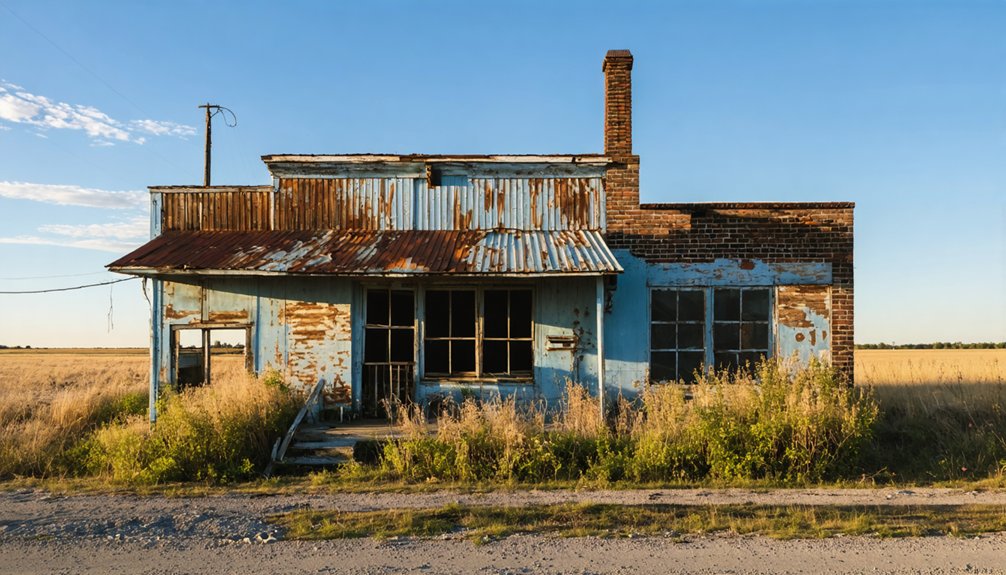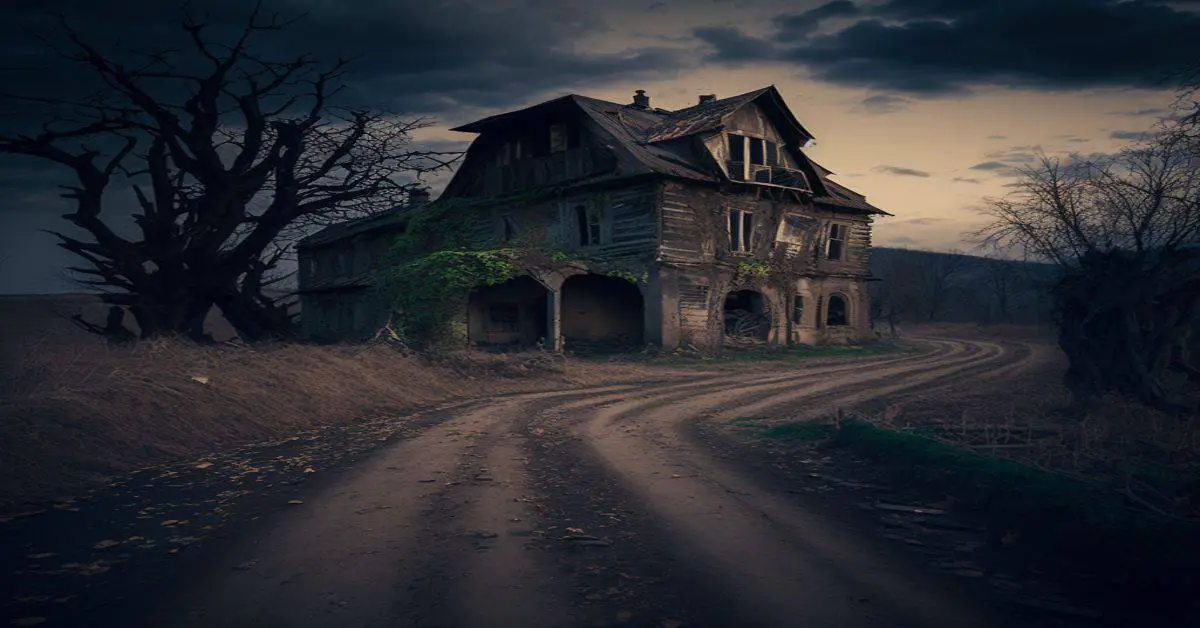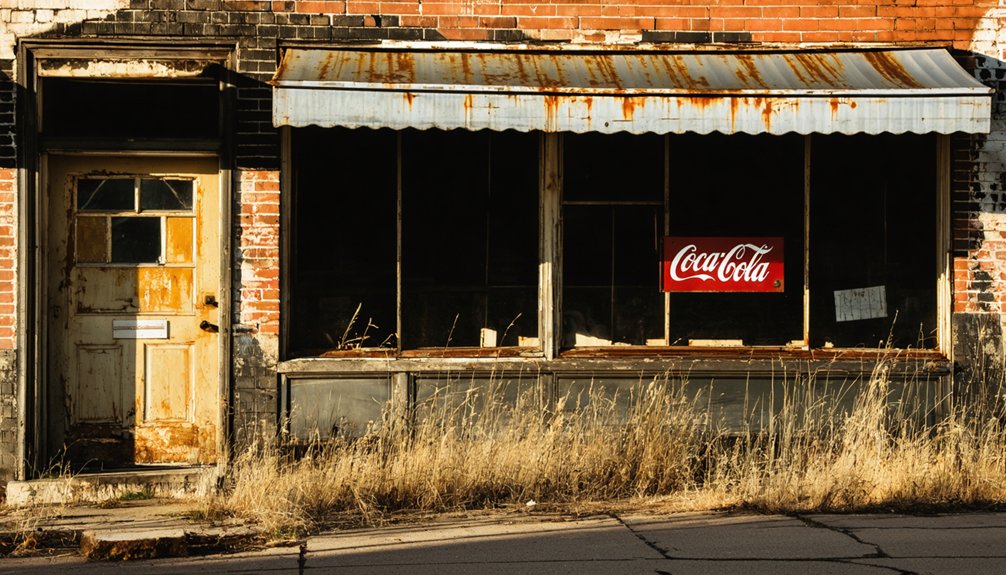You’ll find Westville, Illinois isn’t a ghost town at all, but rather a living representation of America’s industrial heritage. Established in 1885 when Mike Kelly opened coal mines near the Chicago and Eastern Illinois Railroad, the town quickly grew into a thriving mining center. Lithuanian immigrants shaped the community’s cultural identity through churches, cemeteries, and social clubs. While coal mining has ceased, Westville’s preserved landmarks and historical sites reveal fascinating layers of its past.
Key Takeaways
- Westville evolved from a thriving mining boomtown in 1885 to a quieter community after coal operations declined significantly.
- The town’s mining infrastructure, including Kelly No. 3 and Kellyville shafts, now stands largely abandoned as historical remnants.
- Original train depot survives as a museum, preserving railroad memorabilia from Westville’s peak industrial period.
- Lithuanian cemeteries and cultural landmarks remain as testament to the immigrant workers who once populated the bustling town.
- The 1968 Miner’s Memorial serves as a reminder of Westville’s former status as a major coal mining center.
The Birth of a Mining Boomtown
While many Illinois towns grew gradually over decades, Westville’s transformation from quiet farmland to bustling mining center happened almost overnight in 1885.
In a matter of months, Westville erupted from sleepy prairie fields into a vibrant coal mining boomtown that changed Illinois forever.
When Mike Kelly established his first coal mines, you’d have seen an immediate rush of activity as the Chicago and Eastern Illinois Railroad quickly laid tracks to transport both coal and miners to the area.
The town’s strategic location near the Indiana border made it perfect for mining techniques that could tap into the rich Herrin coal seam.
As shaft mines opened one after another, immigrant labor poured in from across Europe, transforming Westville into a diverse, working-class community. Lithuanian immigrants formed a significant portion of the town’s population during its peak years.
The railroad depot became the heart of town, while miners’ families established homes, businesses, and a new way of life in this rapidly expanding settlement. Despite having less than a thousand residents, the town supported sixteen saloons that served as vital gathering places for the mining community.
Lithuanian Heritage and Cultural Impact
As Lithuanian immigrants poured into Westville during the late 1800s, they quickly established a rich cultural footprint that would define the town for generations.
You’d find their influence everywhere – from two distinct religious cemeteries to vibrant cultural festivals that brought the community together. In 1909, the community united to establish a new Lithuanian cemetery that would preserve their history through generations. They built churches, schools, and social clubs where Lithuanian traditions flourished and their native language stayed alive.
Their impact wasn’t limited to culture alone. One of the town’s thirty-six local taverns helped establish a strong social foundation for the mining community.
You’ll discover that Lithuanian-Americans stepped into leadership roles throughout Westville, serving as mayors and public officials. They gathered under football field lights in the 1920s, hosted community events, and created tight-knit neighborhoods where their heritage thrived.
Through art, oral histories, and documented experiences, their legacy lives on as an essential chapter in Westville’s story.
Railroad’s Role in Town Development
Because the Louisville, New Albany and Chicago Railroad arrived in 1851, Westville transformed from a small settlement into a bustling transportation hub. The railroad infrastructure proved essential for your town’s rapid growth, establishing Westville as an important grain shipping center that connected local farmers to broader markets. By 1876, diverse local businesses emerged including attorneys, bakeries, and hotels.
You’d have seen dramatic changes by 1901 when the Danville Paxton & Northern electric interurban line began operating, marking Westville’s second major rail development. The region’s thriving coal mining operations employed thousands of workers, with over 20 million tons annually by 1900. The economic impact rippled through the community, spurring the growth of diverse businesses from livery stables to wagon manufacturers.
Local merchants thrived as the rail network expanded, particularly after the Illinois Traction System incorporated in 1904, connecting Westville to over 400 miles of track. The town’s strategic position in this growing rail network secured its commercial success through the early 20th century.
The Rise and Fall of Coal Mining
The railroad’s arrival set the stage for Westville’s next chapter – the explosive growth of coal mining.
When Mike Kelly started several mines around 1885, you’d have witnessed a dramatic economic transformation as this rural settlement evolved into a bustling mining town.
You would’ve seen immigrant workers flocking to Westville’s mines, which were producing an impressive 2,000 tons of coal per eight-hour shift by 1898.
The Bunsen Coal Company modernized operations with advanced safety equipment and first-aid hospitals, while the Kelly No. 3 and Kellyville shafts tapped into the rich Herrin coal seam.
Workers entered deep shafts using open-sided elevators, descending over 200 feet into the darkness below.
The Chicago and Eastern Illinois Rail Line transported both passengers and coal, making Westville a vital transportation hub.
Sundown Town Legacy and Social History
As you explore Westville’s social history, you’ll find evidence of its status as a probable sundown town through unwritten rules and informal practices that discouraged Black residents from settling in the community.
Historical accounts from the 1960s reveal how the town maintained its nearly all-White demographic through social pressure and oral warnings passed between residents. A telling incident occurred when a Black trick-or-treating family was explicitly informed they were not welcome in the town. Like many communities across Illinois, the town enforced its discriminatory practices through local social engineering.
While formal records of these exclusionary practices are scarce, the oral histories and demographic patterns paint a clear picture of how Westville’s social boundaries shaped its community development well into the twentieth century.
Informal Racial Exclusion Practices
Despite lacking formal ordinances or visible signage, Westville maintained its status as a sundown town through powerful social mechanisms and unwritten rules that effectively excluded Black residents throughout much of the 20th century.
The town’s racial memory reveals how social enforcement operated through community pressure and intimidation rather than legal restrictions.
- Local residents recall specific incidents, like Black children being turned away during Halloween in the 1960s.
- Community-wide understanding perpetuated exclusionary practices without need for written policies.
- Collective social pressure caused Black families to avoid settling in the area.
These informal practices aligned with broader patterns across Illinois, where over 400 sundown towns existed.
The impact of these exclusionary practices continues to shape Westville’s demographics and social dynamics today.
Community Demographics Over Time
From its peak as a thriving coal mining hub in 1920, Westville’s demographic story reflects dramatic shifts in both population size and ethnic composition.
You’ll find that the once-dominant Lithuanian community, which comprised nearly 60% of the town’s 4,241 residents in 1920, has dwindled to less than 5% today. The most striking demographic shifts occurred after mine closures, when many Lithuanian families relocated to Chicago.
The town’s population decline has been steady and significant, dropping to 3,167 by 2020 and projected to fall below 3,000 by 2025.
While the community remains mainly white at 96%, its character has transformed from an immigrant mining town to a more typical rural Illinois community, with rising median age and changing household patterns reflecting broader regional trends.
Unwritten Social Boundaries
While Westville’s historical records contain no formal sundown town ordinances, oral traditions and demographic patterns strongly suggest the community enforced strict racial boundaries throughout much of the 20th century.
The social dynamics relied heavily on unwritten rules and community-enforced exclusion rather than legal documentation.
You’ll find these racial narratives preserved through:
- Verbal warnings passed between residents, including documented incidents of Black families being told to leave town
- Coordinated efforts among landlords, employers, and local authorities to maintain segregation
- Persistent demographic homogeneity reflecting decades of systematic exclusion
These unofficial boundaries shaped Westville’s development, creating lasting effects on housing patterns, business ownership, and social institutions that continue to influence community relationships today.
Present-Day Remnants and Historical Sites

Today in Westville, you can find several significant historical landmarks that tell the story of this once-bustling coal mining town. The original train depot stands as a museum filled with railroad memorabilia, while the 1968 Miner’s Memorial honors the town’s coal mining heritage.
You’ll discover the preserved Ss. Peter and Paul cemetery, a symbol of the strong Lithuanian presence that shaped the community’s identity.
Though many original structures have changed over time, historical preservation efforts keep Westville’s past alive. The remaining taverns and historic homes provide glimpses into daily life during the mining era, while remembrance pathways mark where important cultural institutions once stood.
These sites continue to draw tourism interest from history enthusiasts and descendants of former residents seeking connections to their roots.
Frequently Asked Questions
What Were the Names of the Major Coal Mining Companies in Westville?
You’ll discover five major coal mining companies shaped Westville’s company history: the Dering Coal Company, Kelley Coal Company, Chicago and Eastern Illinois Railroad, Bunsen Coal Company, and U.S. Coal & Coke Company.
How Many Lives Were Lost in Westville’s Mining Accidents?
While you’d want exact mining accident statistics, historical records don’t show precise numbers for Westville’s mining fatalities. Rock falls and explosions claimed lives, but specific mining safety data remains incomplete.
What Happened to the Lithuanian Language Newspapers Published in Westville?
You won’t find many Lithuanian publications from Westville today – they’ve largely disappeared due to financial struggles and declining readership. Most newspaper archives weren’t preserved as the immigrant community gradually assimilated.
Which Prominent Figures or Celebrities Visited Old Westville During Its Peak?
You won’t find records of celebrity sightings in peak-era Westville. The town’s notable figures were local leaders like Mike Kelly, Father Paukstis, and George Miglin running mines, churches, and taverns.
What Was the Average Wage of a Westville Coal Miner?
Like coal dust marking a miner’s face, your ancestors’ daily wages would’ve averaged $5.82 in 1926, though you’d earn more as a specialized worker like a bratticeman at $6.16.
References
- https://libsysdigi.library.illinois.edu/oca/Books2008-06/centennialcelebr00west/centennialcelebr00west.pdf
- https://global.truelithuania.com/westville-illinois-2282/
- https://mythicmississippi.illinois.edu/westville-memorial/
- https://www.youtube.com/watch?v=i_exRQydWyM
- https://www.youtube.com/watch?v=Lvsmx6TCuB8
- https://justice.tougaloo.edu/sundowntown/westville-il/
- https://en.wikipedia.org/wiki/Westville
- https://prohibition.osu.edu/saloons/saloon-illinois
- https://en.wikipedia.org/wiki/List_of_ghost_towns_in_Illinois
- https://www.hmdb.org/m.asp?m=11393



